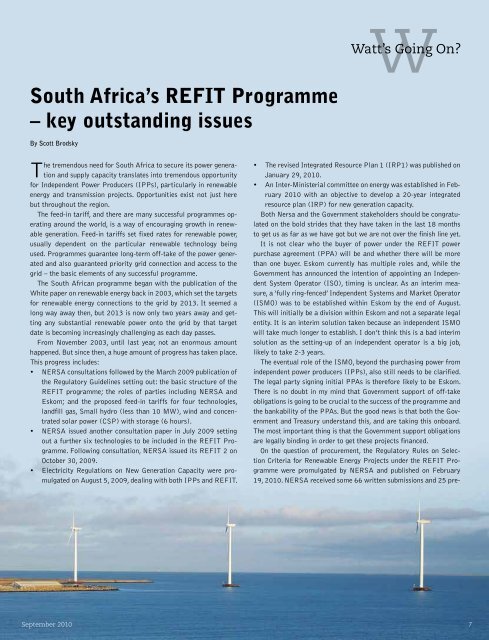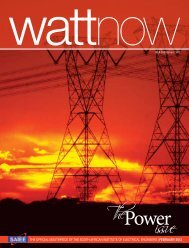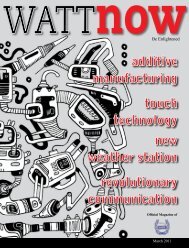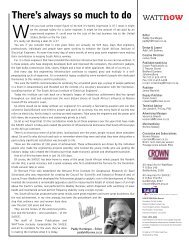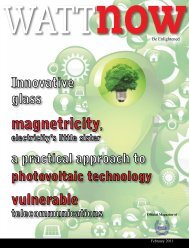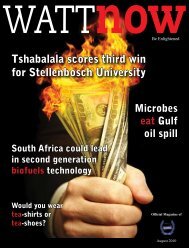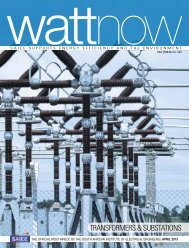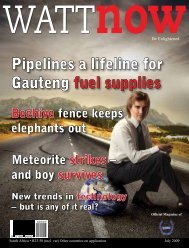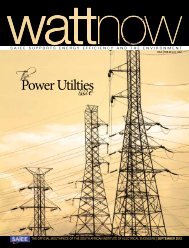download a PDF of the full September 2010 issue - Watt Now ...
download a PDF of the full September 2010 issue - Watt Now ...
download a PDF of the full September 2010 issue - Watt Now ...
- No tags were found...
You also want an ePaper? Increase the reach of your titles
YUMPU automatically turns print PDFs into web optimized ePapers that Google loves.
South Africa’s REFIT Programme– key outstanding <strong>issue</strong>sBy Scott BrodskyThe tremendous need for South Africa to secure its power generationand supply capacity translates into tremendous opportunityfor Independent Power Producers (IPPs), particularly in renewableenergy and transmission projects. Opportunities exist not just herebut throughout <strong>the</strong> region.The feed-in tariff, and <strong>the</strong>re are many successful programmes operatingaround <strong>the</strong> world, is a way <strong>of</strong> encouraging growth in renewablegeneration. Feed-in tariffs set fixed rates for renewable power,usually dependent on <strong>the</strong> particular renewable technology beingused. Programmes guarantee long-term <strong>of</strong>f-take <strong>of</strong> <strong>the</strong> power generatedand also guaranteed priority grid connection and access to <strong>the</strong>grid – <strong>the</strong> basic elements <strong>of</strong> any successful programme.The South African programme began with <strong>the</strong> publication <strong>of</strong> <strong>the</strong>White paper on renewable energy back in 2003, which set <strong>the</strong> targetsfor renewable energy connections to <strong>the</strong> grid by 2013. It seemed along way away <strong>the</strong>n, but 2013 is now only two years away and gettingany substantial renewable power onto <strong>the</strong> grid by that targetdate is becoming increasingly challenging as each day passes.From November 2003, until last year, not an enormous amounthappened. But since <strong>the</strong>n, a huge amount <strong>of</strong> progress has taken place.This progress includes:• NERSA consultations followed by <strong>the</strong> March 2009 publication <strong>of</strong><strong>the</strong> Regulatory Guidelines setting out: <strong>the</strong> basic structure <strong>of</strong> <strong>the</strong>REFIT programme; <strong>the</strong> roles <strong>of</strong> parties including NERSA andEskom; and <strong>the</strong> proposed feed-in tariffs for four technologies,landfill gas, Small hydro (less than 10 MW), wind and concentratedsolar power (CSP) with storage (6 hours).• NERSA <strong>issue</strong>d ano<strong>the</strong>r consultation paper in July 2009 settingout a fur<strong>the</strong>r six technologies to be included in <strong>the</strong> REFIT Programme.Following consultation, NERSA <strong>issue</strong>d its REFIT 2 onOctober 30, 2009.• Electricity Regulations on New Generation Capacity were promulgatedon August 5, 2009, dealing with both IPPs and REFIT.• The revised Integrated Resource Plan 1 (IRP1) was published onJanuary 29, <strong>2010</strong>.• An Inter-Ministerial committee on energy was established in February<strong>2010</strong> with an objective to develop a 20-year integratedresource plan (IRP) for new generation capacity.Both Nersa and <strong>the</strong> Government stakeholders should be congratulatedon <strong>the</strong> bold strides that <strong>the</strong>y have taken in <strong>the</strong> last 18 monthsto get us as far as we have got but we are not over <strong>the</strong> finish line yet.It is not clear who <strong>the</strong> buyer <strong>of</strong> power under <strong>the</strong> REFIT powerpurchase agreement (PPA) will be and whe<strong>the</strong>r <strong>the</strong>re will be morethan one buyer. Eskom currently has multiple roles and, while <strong>the</strong>Government has announced <strong>the</strong> intention <strong>of</strong> appointing an IndependentSystem Operator (ISO), timing is unclear. As an interim measure,a ‘<strong>full</strong>y ring-fenced’ Independent Systems and Market Operator(ISMO) was to be established within Eskom by <strong>the</strong> end <strong>of</strong> August.This will initially be a division within Eskom and not a separate legalentity. It is an interim solution taken because an independent ISMOwill take much longer to establish. I don’t think this is a bad interimsolution as <strong>the</strong> setting-up <strong>of</strong> an independent operator is a big job,likely to take 2-3 years.The eventual role <strong>of</strong> <strong>the</strong> ISMO, beyond <strong>the</strong> purchasing power fromindependent power producers (IPPs), also still needs to be clarified.The legal party signing initial PPAs is <strong>the</strong>refore likely to be Eskom.There is no doubt in my mind that Government support <strong>of</strong> <strong>of</strong>f-takeobligations is going to be crucial to <strong>the</strong> success <strong>of</strong> <strong>the</strong> programme and<strong>the</strong> bankability <strong>of</strong> <strong>the</strong> PPAs. But <strong>the</strong> good news is that both <strong>the</strong> Governmentand Treasury understand this, and are taking this onboard.The most important thing is that <strong>the</strong> Government support obligationsare legally binding in order to get <strong>the</strong>se projects financed.On <strong>the</strong> question <strong>of</strong> procurement, <strong>the</strong> Regulatory Rules on SelectionCriteria for Renewable Energy Projects under <strong>the</strong> REFIT Programmewere promulgated by NERSA and published on February19, <strong>2010</strong>. NERSA received some 66 written submissions and 25 pre-<strong>September</strong> <strong>2010</strong> 7


